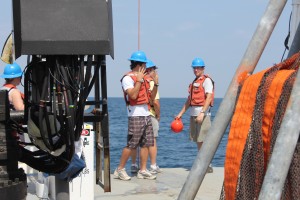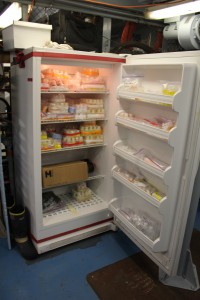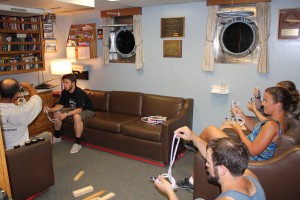Land Ho!
 It’s beginning to set in that the end of our expedition is near. Today the last deployal of the two Landers as well as final GO-Flo’s and In-Situ Pumps were performed. The team is starting to take apart their equipment and pack up their gear and samples for the trips home.
It’s beginning to set in that the end of our expedition is near. Today the last deployal of the two Landers as well as final GO-Flo’s and In-Situ Pumps were performed. The team is starting to take apart their equipment and pack up their gear and samples for the trips home.
Scientists are on board from states as far as Oregon, Califo rnia, New Jersey, and as close as Louisiana. Shipping arrangements have to be made to get their equipment to their respective states and as soon as possible. Many of the samples collected must remain refrigerated, or even frozen, during their trip, making a timely arrival imperative. Keeping the samples cool minimizes any chemical or biological activity that could possibly be taking place in the samples. Any plankton or other microorganisms that were left in the samples could continue to respire or photosynthesize, resulting in a change in the chemical makeup of the sample from when it was collected. Cooling the samples reduces (or stops) these biological (and other chemical) processes from happening, preserving the water as it was removed from the sea.
rnia, New Jersey, and as close as Louisiana. Shipping arrangements have to be made to get their equipment to their respective states and as soon as possible. Many of the samples collected must remain refrigerated, or even frozen, during their trip, making a timely arrival imperative. Keeping the samples cool minimizes any chemical or biological activity that could possibly be taking place in the samples. Any plankton or other microorganisms that were left in the samples could continue to respire or photosynthesize, resulting in a change in the chemical makeup of the sample from when it was collected. Cooling the samples reduces (or stops) these biological (and other chemical) processes from happening, preserving the water as it was removed from the sea.
Chris Moser started taking the multi-corer down today. As he was dismantling this extremely heavy piece of equipment (it weighs over 1000 pounds including the weights added to it to help it sink into the sea floor), a pod of dolphins feeding in the background caught our attention. They stayed near the ship for the better part of the day, apparently feeding, before moving on.
 Once in a while on board the Endeavor we have a free evening. A couple of those nights our Boson, Patrick Quigley, was kind enough to offer “Marlin Spike Seamanship Class” to several of us who were interested in learning how to tie knots. When you take knot class you must remember that you are not tying a rope, that is a taboo word on the Endeavor; the proper word for what would be rope on land is “line” out on the seas. Patrick taught us how to tie several different knots including the bowline, square knot, the running bowline, French bowline, and of course the “Tom-fools” knot, among others. After we proved our knots Patrick taught us three different splicing techniques. Splicing is when you join a line to itself, or connect two separate pieces of line. At the end of the lesson we even had an oral quiz. What makes a good knot?” Patrick asked Jesse. “It’s easy to tie, and easy to untie…” is the correct answer Jesse offered Patrick. We also learned the difference between a knot, a hitch, and a bend. A knot is a line that is tied to itself, a bend ties two separate lines together, and a hitch is a line that is tied to an object.
Once in a while on board the Endeavor we have a free evening. A couple of those nights our Boson, Patrick Quigley, was kind enough to offer “Marlin Spike Seamanship Class” to several of us who were interested in learning how to tie knots. When you take knot class you must remember that you are not tying a rope, that is a taboo word on the Endeavor; the proper word for what would be rope on land is “line” out on the seas. Patrick taught us how to tie several different knots including the bowline, square knot, the running bowline, French bowline, and of course the “Tom-fools” knot, among others. After we proved our knots Patrick taught us three different splicing techniques. Splicing is when you join a line to itself, or connect two separate pieces of line. At the end of the lesson we even had an oral quiz. What makes a good knot?” Patrick asked Jesse. “It’s easy to tie, and easy to untie…” is the correct answer Jesse offered Patrick. We also learned the difference between a knot, a hitch, and a bend. A knot is a line that is tied to itself, a bend ties two separate lines together, and a hitch is a line that is tied to an object.
After Marline Spike Seamanship Class it was time to head off to bed to get ready for our final full day on the Endeavor tomorrow. The last few weeks have been pretty amazing. As educators, Cris and I are very thankful and thrilled that the Scientists on board were kind enough to share their living space, time, and knowledge with us, giving us the opportunity not only to learn for ourselves, but to take the invaluable lessons we learned out here at sea back to our students at home. Thank you to all crew and scientists who made this trip possible for two educators on a quest to learn more.
Signing off for the last time,
Wessal


 August 18, 2011
August 18, 2011 






Recent Comments